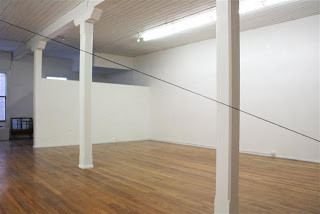


Patrick Lundberg’s installation at HSP met with mixed reactions. The work was executed with minimal means while the artist’s statement was fairly thick with meaning, and difficult to work out. There was quite a difference between the proposed and the actual work. The proposal images showed quite elaborate shapes and patterns created by cutting and pealing away wallpapered surfaces. The actual work was mainly comprised of four lengths of string stretching across perpendicular walls on a diagonal angle. The artist also removed our office and storeroom doors and placed a glass full to the rim with blue ‘power-aid’ (to ‘anchor’ the work).
While some felt the project was light on work, I personally felt impressed with what the artist had achieved with such minimal means. The string was very cleverly inserted into the walls, so as to give the impression of being threaded through the wall. There was a sense of an engineering-like level of precision; the string was perfectly tort, creating a true plane, and the angles seemed accurate and purposeful. During the install we talked about the artist’s motivation. Patrick explained his response in terms of the central axis and symmetry of the gallery space. By imaginatively dividing the space length ways, the artist noticed that it is as though one side mirrors the other, except that it has been ‘flipped’ over. So, at one end there is the store room door, diagonally there is the office door, and so on. The idea of removing the doors was motivated by a desire to reveal what is usually hidden behind the walls. This was a development from his previous work, where the wall itself had been revealed behind the layers of wall covering.
Some of the most enthusiastic viewers were among the group from Timaru Boys High. I talked a little about the work and left them to consider it for themselves. After a few minutes a student hauled me out of the office to show me a visual illusion caused by the string – as the shorter length was approached an illusion of a vertical plane was created. The peculiar thing was that, although I hadn’t seen anything of the sort earlier, once it was described, and I was standing in the right place, it became visible – a faint optical illusion as if a large sheet of glass or similar were installed there. I later showed this to an HSP board member, who commented that in the opposite corner the string appeared as a line drawn in pencil on the wall. Once so described, this became visible too.
Now, I’m not usually so suggestible as to visualize images based on mere description. The ability to play with our perceptions was a subtle, but important, element of this work. If the work had been more visually ‘busy,’ I doubt these shifts in perception would have occurred at all. In his statement the artist said:
“Within this framework the absolute value of formal relations is disregarded in favour of a delicate and fragile dialogue with the contingencies of this site. Thus, their symbolic power as models of ethics and knowledge is re-aligned by our experience of their lightness and vagrancy. Error, complexity, contradiction and fragility are present as being central to apprehending the universal”.
Contemporary artists are often criticised for the grand statements made about minimal works. In this instance I felt that the artist’s statement represented informative, if dense, communication about his concerns; rather than a vacuous attempt at impressiveness.

State: My practice as a painter is framed by specific interests in its relation to architectural and physical/sculptural space, and also in negotiating and amplifying the relationship with performance which is commonly latent in painterly procedure. My impulse to explore these ‘grey’ territories of painterly practice is derived from a desire to shift meaningful pictorial or optical formal relations into, rather than abandon them for, physical space. Paintings instant or simultaneous time becomes subject to our experience of time as passage. We can count the hours until work is gone. As such it exists as an ephemeral experience, to be experienced not unlike fireworks, or any other potent temporal event.
Within this framework the absolute value of formal relations is disregarded in favour of a delicate and fragile dialogue with the contingencies of this site. Thus, their symbolic power as models of ethics and knowledge is re-aligned by our experience of their lightness and vagrancy. Error, complexity, contradiction and fragility are present as being central to apprehending the universal.

